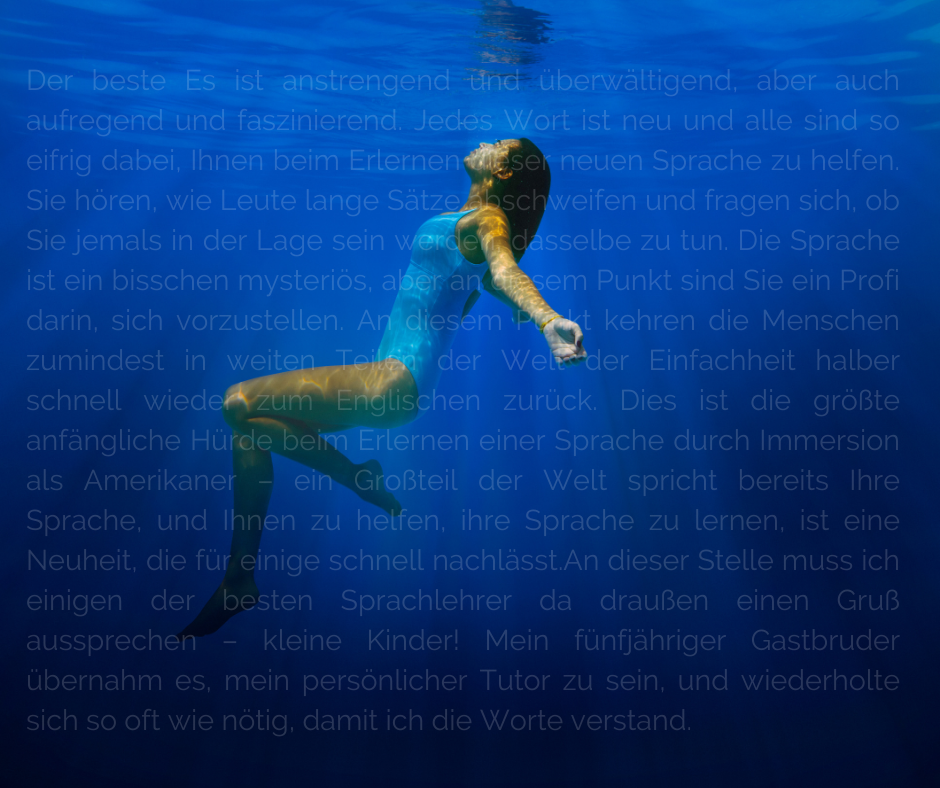Explore web search results related to this domain.

Discover the secret to mastering a new language at home with these 5 easy immersion activity ideas. ... In my experience as an English as a Second Language (ESL) teacher, I found that my students learned better by actively surrounding themselves with English in their daily lives.
Take it easy and explore immersion activities you truly enjoy. After all, learning a new language should be a fun experience rather than a frustrating chore! ... Jane Pardo is a senior contributing writer with three years of experience as an English as a Second Language (ESL) teacher, offering expert insights on language learning.The best immersion activity ideas are finding a language exchange partner and designing an immersion zone. Learn how to implement them effectively.Read on to learn the benefits and how to effectively implement my top five recommendations for immersive learning activities you can do at home. Mutual learning with a native speaker or fluent partner offers opportunities for intercultural conversations. A recent study found that Chinese postgraduate students using a language exchange app improved their speaking skills and willingness to communicate more than students doing traditional classroom tasks.Make it fun: Sing a song in your target language or name items as you see them. Reading out loud, writing in your journal, and playing language learning games on your target language’s server are also exciting immersion activity ideas.
Learning a language can be done well--and quickly--by total immersion into a family and culture.
While classroom language classes have their place - sometimes it's nice to not need to travel halfway around the world - immersion is an entirely different experience with so many advantages, challenges, and rewards. Unlike classroom learning, immersion learning is not constantly disrupted by a return to your native language.At this point, at least in much of the world, people quickly revert back to English for convenience sake. This is the biggest initial hurdle to learning a language through immersion as an American - much of the world already speaks your language, and helping you learn theirs is a novelty that quickly wears off for some.Classroom learners are typically stronger on the mechanics and grammar of a language while immersion learners are more comfortable in day-to-day conversation and speak more like a native.Language learning through immersion has a snowball effect. Once that snowball grows large enough, you suddenly feel like you are improving by leaps and bounds instead of taking baby steps.

Explore our blog to learn about immersive language-learning experiences, how to create them and the benefit of them in learning English.

English as a Second Language (ESL) Souhaitez-vous obtenirdes services en français? Si oui, cliquez ici ou téléchargez la brochure ici What's New? Morning, Afternoon, Evening,
Technology: Navigate digital tools and text that will assist with learning, employment and everyday activities · Portfolio Based Language Assessment is a standard in-class assessment process that instructors use in all St. Louis ESL and LINC classes in Canada as a way to measure your language abilities.While ESL adult parents are learning or improving their English language skills, their pre-school children are as well…ESL is offered at multiple locations at various times through St. Louis Adult Learning and Continuing Education Centres. Please find below the class dates, times and locations that these programs are offered. All ESL classes begin again September 9, 2024.Louis ESL program does not provide free child care. ... Warm and caring staff strive to provide fun and educational activities to support children’s settlement in Canada. The best possible atmosphere for children’s development and learning is created by establishing relationships between staff and families built on mutual respect.

We have gone through everything you need to know about language immersion. You'll learn what it is, how to do it and what the benefits are.
Language immersion is often hailed as the most efficient way to learn a new language. Fundamentally, it means surrounding yourself with the target language in every possible way: reading, listening, writing, and speaking. While this method is highly effective for some, it’s essential to recognize that it’s not the silver bullet that works for everyone.The language immersion method is an approach where you place yourself in an environment where your target language is used exclusively. This means everything you hear, read and say is in the language you are trying to learn. The idea is that when you surround yourself with the language in various contexts and forms, it gives you a natural exposure to the language.You get to live, feel, and learn the language in its purest and most natural form – much like a child learning their native tongue. In classroom settings, they often use different variants of the language immersion method, for example:The language immersion method involves learning a language in an environment that operates solely in your target language. Of course, the best way to achieve this is to live in a country where the language is spoken, but that’s not an option for everyone.

One of the greatest joys of language learning is taking inspiration from others’ processes and creating modified versions to suit your needs. If you push against the language hard enough, you develop…
One of the greatest joys of language learning is taking inspiration from others’ processes and creating modified versions to suit your needs. If you push against the language hard enough, you develop an instinct for which methods produce the best results.Language learner. Rapidly learning the Finnish language.Optimizing both efficiency and engagement

This is my eighth update for my Spanish learning journey with the refold approach. For my first update, see here. For my second update, see here. For my third update, see here. For my fourth update…
My Eighth Update about Learning Spanish in a NutshellI’ve only finished one book during this time: Olvidado Rey Gudú. I have a larger blog post reviewing the book here, but in-short, there’s really nothing like it in the English language. Worth learning Spanish for in my opinion. Otherwise, I’ve been immersing in a variety of different domains.When are the inflection points you’ve noticed in your learning? Full immersion link data link. If you enjoyed this article, you can sign up for my mailing list here. I blog about language learning, biology, the science and art of learning, and many other thingsThis is my eighth update for my Spanish learning journey with the refold approach. For my first update, see here. For my second update, see here. For my third update, see here. For my fourth update, see here. For my fifth update, see here. For my sixth update, see here. For my seventh update, see here. For more information about the Refold approach, see here. For a basic Spanish Anki vocabulary deck, see here. Reached 1000 hours of immersion.
Find out how to immerse yourself in a new language, our top language immersion tips, and what NOT to do! ... First things first, what exactly is immersion-based learning? Immersion-based learning means learning a language in the most authentic and natural way possible.
Find out how to immerse yourself in a new language, our top language immersion tips, and what NOT to do! ... First things first, what exactly is immersion-based learning? Immersion-based learning means learning a language in the most authentic and natural way possible.For one, since the start of the pandemic it’s become more difficult to experience total immersion by travelling to other countries. This means fewer chances to truly get a first hand experience of authentic language and culture (Thanks, COVID). Add to that the hundreds of different podcasts, apps, youtube videos and books that are thrust at you when you start to learn a new language and immersion becomes more of a confusing pain than a useful concept.We’ve established that immersive language learning usually means learning a new language in the most natural way possible. In practice, it would mean living in the country where the language is spoken. However, as this isn’t currently an option, it’s necessary to find other ways to immerse yourself.There are several benefits to learning a language through immersion. When you learn a new language, you can interact with native speakers and constantly develop proficiency by adding new vocabulary and contexts to your understanding.

Two-way immersion programs in the US promote L1 speakers of a language other than English to maintain that language as well as to teach English as a second language (ESL).
Two-way immersion: This type, which is also called bilingual immersion, is a way to integrate both students of the minority language and students of the majority language into the same classroom with the goal of academic excellence and bilingual proficiency for both student groups. In this type of language immersion, the instructional languages can be two languages, but only one language is used at a time. Students learn languages by the interaction with their peers and teachers.This method of language immersion is popular language in America. ... Early immersion: Students start learning their second language at the age of 5 or 6.Late partial immersion: education in L2 at 50%, usually beginning on sixth or seventh grade. In foreign language experience or exploratory (FLEX) programs, students are exposed to a different language(s) and culture(s) in the classroom. A small percentage of class time is spent sampling one or more languages and/or learning about language and so proficiency in the target language is not the primary goal.However, many factors may affect immersion during study abroad, including the amount of foreign-language contact during the program. To impact competence in the target language positively, Celeste Kinginger notes, research about language learning during study abroad suggests "a need for language learners' broader engagement in local communicative practices, for mindfulness of their situation as peripheral participants, and for more nuanced awareness of language itself.”Language immersion, or simply immersion, is a technique used in bilingual language education in which two languages are used for instruction in a variety of topics, including maths, science, or social studies. The languages used for instruction are referred to as the L1 and the L2 for each ...


We've tested a lot of different language learning apps, from Duolingo to Rosetta Stone. These are our top picks.
This app is unique in how it approaches teaching Spanish and German. Instead of traditional teaching methods for learning a language, Lirica uses popular music by Latin and reggaeton artists to help you learn language and grammar. On top of learning the language, you're also immersing yourself in the culture behind it.There are a lot of reasons why you might be interested in learning a new language, whether it's in preparation for an international vacation, to bolster your education or just for fun. But once you decide to start, it can feel overwhelming trying to figure out where to begin.Language apps or other online services can help you build a solid foundation of vocabulary and grammar to help you learn to speak and read in another language. CNET has tested many different apps, comparing their lesson structures, features, the number of languages they offer, pricing tiers and the different learning methods they use.As a regular Duolingo user, I enjoy the app's colorful interface and short, game-like exercises. The app doesn't restrict how many languages you can try to learn at the same time (personally, I think two is a good maximum if you want to retain anything). I use Duolingo to practice Spanish and German, but it offers lessons in over 40 languages.
Learning a language through immersion means completely surrounding yourself with the language you are learning. For school-age children, this could mean learning maths, science and other subjects through the medium of that language.
So, what exactly is the fastest, most effective way to learn a new language? Enter: The immersive learning method.Learning a language through immersion means completely surrounding yourself with the language you are learning. For school-age children, this could mean learning maths, science and other subjects through the medium of that language.After five months, both groups retained the language even though they had not used it at all, and both displayed brain processing similar to that of a native speaker. However, it was discovered that the immersion group displayed the full brain patterns of a native speaker, meaning they showed “native-like neural processing of syntax.” · The reason why immersion learning really works is that it puts your language learning in context.The problem is that the majority of us can’t simply drop everything, move halfway across the world and dedicate all our time to language learning. It’s simply not practical. But don’t despair. There are plenty of ways that you can integrate the immersion method into your day-to-day life, no matter where in the world you’re living.


Successful language learners agree that languages are best learned best with live immersion — I do this whenever I can. But dropping everything and blowing $2000 on a flight to Tokyo…not everybody…
With it, you can get 80% or more of the effects of live immersion without ever leaving home. This is what I did for my first year of Japanese study. My university was in a small rural town in Florida. There were hardly a dozen Japanese speakers in the whole county! All successful language learners I know use this method in one form or another.When I was learning Japanese, I would get 14+ hours of language exposure on some days. University language classes rarely go above even 5 hours a week. Non-Additive — Adding too much to a busy schedule is a recipe for failure. Simulated immersion just switches daily life…What is the secret to language immersion?

Try our quiz to see how well you've learned today's language.
Teenage climate change activist Greta Thunberg makes her feelings clear to world leaders at the UN climate change summit in New York. Neil and Catherine teach you the language the media is using to discuss this story.Now you've watched the video, try to answer these questions about the language in the news.
Immersion simply means exposing yourself to the language by watching TV, reading books, and browsing the internet. “We all acquire language in the same way: by understanding messages.“–Stephen Krashen · Learning the definition of a word is just the first step in the process of acquiring it.
Immersion simply means exposing yourself to the language by watching TV, reading books, and browsing the internet. “We all acquire language in the same way: by understanding messages.“–Stephen Krashen · Learning the definition of a word is just the first step in the process of acquiring it.The key to staying motivated is to make your immersion fun. You can watch TV shows, YouTube, and TikTok videos. You can read tweets, blog posts, or books. Any media you enjoy in your NL you can also enjoy in your target language (TL). The average American spends 11 hours per day watching TV, streaming videos, and browsing social media. The more media time you convert to your TL, the faster you will become fluent. The actual time it takes varies depending on the language you’re learning and many other personal factors, but the most important piece is to spend a lot of time with the language.You probably don’t know the grammar rules of your NL. You just speak and the words come naturally. This instinct is the result of language “acquisition”. Once you’ve acquired a language, you will be able to speak the language without thinking. Immersion is the tool we use to acquire language.Most language teachers instruct you to memorize words and grammar and then combine them to construct sentences. This way of learning is called the “skill-building” approach.
You might lend a hand by watching ... take ESL classes, helping translate basic information, serving as an English conversation partner or driving people to medical appointments. Look for postings on sites like Craigslist or VolunteerMatch, or see if your city has a volunteer match program of its own. Most of your time is probably spent doing your “day job,” so this is an ideal place to look for additional opportunities to study the language you want to learn...
You might lend a hand by watching kids while their parents take ESL classes, helping translate basic information, serving as an English conversation partner or driving people to medical appointments. Look for postings on sites like Craigslist or VolunteerMatch, or see if your city has a volunteer match program of its own. Most of your time is probably spent doing your “day job,” so this is an ideal place to look for additional opportunities to study the language you want to learn.Wondering how to immerse yourself in a language without having to travel? Use these 21 great at-home tips and resources to immerse yourself and become fluent faster! From work to meals to technology, you'll learn to surround yourself in your target language.Immersion is an important part of becoming fluent in a foreign language—and you can do this without leaving your country or even your home. After all, many people don’t have the time, money or desire to be an expat, but they’ve successfully learned languages.The key is to put yourself into situations where language learning is inevitable. Here are 21 practical ways to immerse in another language regularly, from conversation clubs to cooking.

TEFL Online. ✅ TEFL courses. ✅ Accredited Certification. ✅ Are you interested in knowing more about The Immersion Method of Teaching English as a Second Language? Check out one of the thousands of TEFL / EFL / ESL articles produced by ITTT's students; There are various different methods ...
✅ TEFL Online. ✅ TEFL courses. ✅ Accredited Certification. ✅ Are you interested in knowing more about The Immersion Method of Teaching English as a Second Language? Check out one of the thousands of TEFL / EFL / ESL articles produced by ITTT's students; There are various different methods which are used to teach a second language.Immersion language teachers provided ideally at least half a day (partial immersion) for students in the language they are targeted to learn and often students receive a full day (total immersion). Immersion programs do not ask the student to forget their first language and as teachers are usually themselves bilingual they tend to be more empathetic to the student's difficulties in learning a second language.How does the immersion method compare with other methodologies ' ' Students who have passed four years of high school French have gone to Paris and been unable to talk to people on the street because they have not learned enough French through the traditional methods of foreign language teaching focusing on grammar translation from language one to language two ' (Reyhner, J). The audiolingual approach in the 1960s focused on speaking and listening rather than reading and writing and in the 1970s various communicative methods were introduced to better effect. However, in moving from an extreme

To encourage language immersion in your classes, label objects and areas in the classroom with words in English. Create themed murals with English vocabulary that children can observe and consult. Use posters, cards and visual material with images and words in English to reinforce vocabulary ...
Language immersion in your classes allows you to offer an experience of comprehensive learning for boys and girls, which combines language acquisition with cultural development. This allows practice the language continuously, improve communication skills and acquire a deep understanding of English in a real context.In early childhood education, language immersion is essential for effective English learning.To encourage language immersion in your classes, label objects and areas in the classroom with words in English. Create themed murals with English vocabulary that children can observe and consult. Use posters, cards and visual material with images and words in English to reinforce vocabulary and grammatical structures.Use educational games, puzzles and digital resources in English to practice the language interactively. Integra Songs, rhymes and videos in English that reinforce vocabulary and language skills. This is a way to enhance language immersion in your classes in a fun and subtle way!


Immersion is an interesting topic for language learners at all levels, and one of those words that always come up in language learning. There’s a lot of misinformation and myths surrounding this topic. In this blog post, we’ll explore whether immersion truly helps you learn a language faster.
In this discussion, we will explore the potential benefits and challenges of immersion courses, and consider whether it suits your individual learning goals and preferences. We will examine what immersion entails, how it can enhance your results when you learn languages, and whether it aligns with your personal learning style.The OED has immersion as the "deep mental involvement in something" and points out that in foreign language learning it means _your teacher will only teach you using the foreign language_. That's all - immersion is not dependent on where you take the class or who you're learning with, it just means fewer explanations and more target language content.And all of this is kinda true - immersion works particularly well when building up to bilingualism, that means speaking two languages at practically native level all the time. This type of class challenges the brain in unique ways while forcing a learner to engage with the way language is used.There's no time for getting lost in grammar and rules, the point is to listen, copy and learn how to use language to be understood immediately. Some more reading about the advantages of immersion can be found over at Omniglot.
Immersion is the tool we use to acquire language. Immersion simply means exposing yourself to the language by watching TV, reading books, and browsing the internet.
Immersion simply means exposing yourself to the language by watching TV, reading books, and browsing the internet. “We all acquire language in the same way: by understanding messages.“–Stephen Krashen · Learning the definition of a word is just the first step in the process of acquiring it.The key to staying motivated is to make your immersion fun. You can watch TV shows, YouTube, and TikTok videos. You can read tweets, blog posts, or books. Any media you enjoy in your NL you can also enjoy in your target language (TL). The average American spends 11 hours per day watching TV, streaming videos, and browsing social media. The more media time you convert to your TL, the faster you will become fluent. The actual time it takes varies depending on the language you’re learning and many other personal factors, but the most important piece is to spend a lot of time with the language.You probably don’t know the grammar rules of your NL. You just speak and the words come naturally. This instinct is the result of language “acquisition”. Once you’ve acquired a language, you will be able to speak the language without thinking. Immersion is the tool we use to acquire language.Most language teachers instruct you to memorize words and grammar and then combine them to construct sentences. This way of learning is called the “skill-building” approach.
Language immersion, or also immersion program, is a learning method used in language education for which every single activity a student performs is carried out in a foreign language. The language is therefore not simply taught as a subject to learn, but as a tool for students to communicate, ...
A language immersion program is by far the fastest way to learn a foreign language. From two-week French courses on the beaches of Nice to 9 months learning Italian in Rome, we have an exciting variety of immersion programs for adults and students.Language immersion, or also immersion program, is a learning method used in language education for which every single activity a student performs is carried out in a foreign language. The language is therefore not simply taught as a subject to learn, but as a tool for students to communicate, learn and have fun.This technique is the one by which we all learn our native language in our first years and it has shown to be the most effective. Yes, language immersion programs are worth it. Not only this type of program speeds up the learning process, but it also enriches the experience for the student.During an immersion program, the student receives practical examples of how to use expressions and words and they are able to memorize their correct use in a shorter time. Additionally, their engagement and commitment in learning the language are stronger as they see results of their effort in the everyday life.









